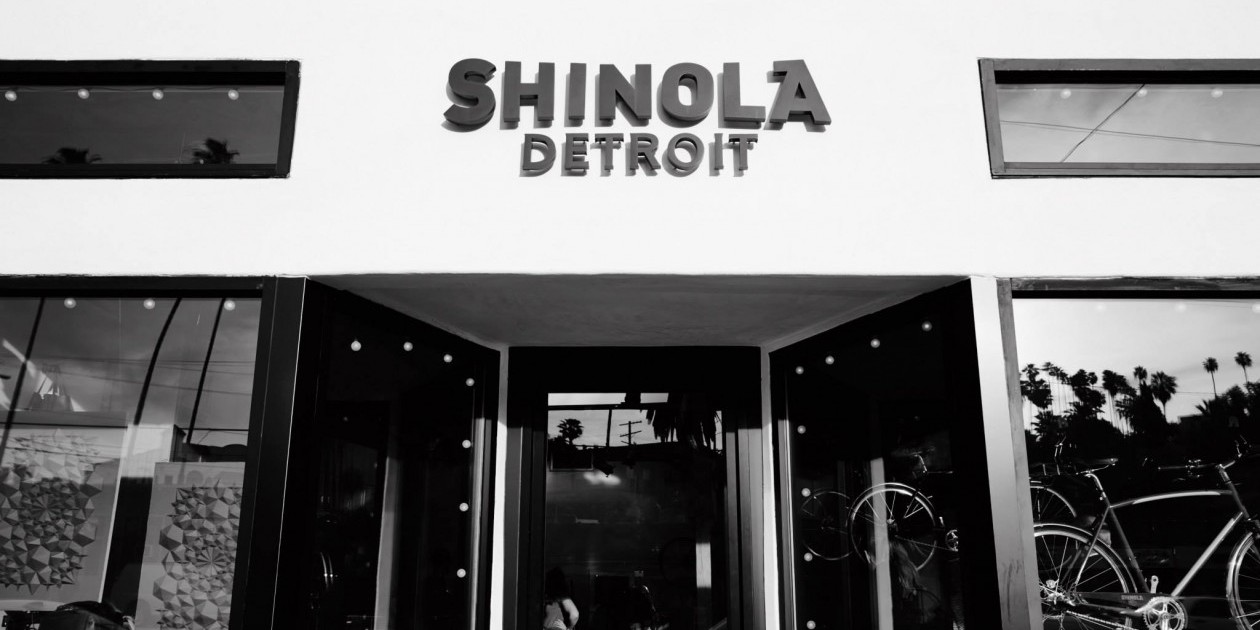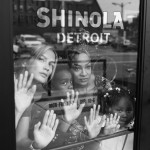 Everyone loves an underdog and if ever there was one, it’s Detroit—a city coming back from the brink after decades of decline.
Everyone loves an underdog and if ever there was one, it’s Detroit—a city coming back from the brink after decades of decline.
That “rising-from-the-ashes” storyline has helped catapult Shinola, a four-year-old company that makes high-end watches, bicycles and leather goods in the Motor City, into one of the hottest brands in America.
The fast-growing company, which does US$100 million in sales, opened its first retail location in midtown Detroit in 2014. It now has 14 stores across the U.S. and one in London, U.K., and plans to add eight to 10 stores each year. This June, Shinola is opening its first Canadian location—at Queen and Ossington in Toronto.
Shinola’s classic-looking goods are certainly a big part of the company’s success, but the real sell is Detroit itself. Shinola has woven Detroit into nearly every facet of its brand, from its tagline, “Where American is Made,” to its watches stamped “Built in Detroit.” It’s a compelling narrative about the rebirth of manufacturing in Detroit and Shinola’s own role in the city’s renaissance.
“Even if you’re not from Detroit or you’ve never been to Detroit, everyone wants to see it succeed,” says Bridget Russo, chief marketing officer at Shinola, from the company’s fourth-floor headquarters in a historic building that was once a former research lab for General Motors. (The watches and leather goods are made on the fifth floor.) “There is a ‘Detroit’ in many places around the world, not just in the United States. So, I think people can relate and ultimately it’s a sign of hope.”
Shinola is the brainchild of Fossil Group founder Tom Kartsotis, who now runs Texas-based investment group Bedrock Brands. Shinola was the name of an American shoe polish brand that was founded in 1907 and became known for the phrase, “You don’t know sh*t from Shinola.” The company went out of business in 1960, and Kartsotis bought the rights to the name in 2011. The idea was to bring back watchmaking to America and create a brand with a social cause of sorts.
“Part of why we chose Detroit is we wanted to be in a city that had some sort of manufacturing background and also a city where we can make an impact—in our case, creating jobs,” says Russo. “And the people were extremely supportive and really had a spirit that we felt is the heart and soul of the brand.”
Allen Adamson, founder of New York-based Brand Simple Consultancy, says if Shinola had opened up in North Carolina, it would have been a non-story. “They went to the worst-case scenario, where the perception was [that Detroit] was a total abysmal failure in every respect and said ‘people here know how to make things and they’re craftspeople and they care,’” says Adamson.
To some extent, Shinola had the right idea at the right time, he adds. “Millennials in particular seek out companies that are both authentic and are good social citizens. So that’s the sweet spot for what attracts them.” On top of that, Shinola’s products are good, says Adamson. “They’re marketed well and they’re designed well, in each of the categories.”
Shinola launched in 2012 with a website that showed early prototypes of watches and bicycles. It also previewed its partners, including Swiss watchmaker Ronda AG, which supplies Shinola’s movement components, and Waterford Precision Cycles in Wisconsin, which supplies bike frames. (Shinola bikes are assembled at the Detroit flagship.) Also that year, Shinola started building followers on Facebook and Twitter, and getting media attention in niche publications and blogs.
In early 2013, when Russo came on board, the company hired New York-based Partners & Spade, which helped Shinola build its ecommerce site and put a stake in the ground with its Detroit-focused messaging, starting with: “The long tradition of Detroit watchmaking has just begun.”
 That was the headline Shinola used to promote its first watch for the market in March 2013: the Runwell. The limited-edition watch cost US$550 and wouldn’t even ship until July. Shinola took out print ads in the New York Times, USA Today, Detroit Free Press and the Wall Street Journal, and 2,500 watches sold out in just eight days.
That was the headline Shinola used to promote its first watch for the market in March 2013: the Runwell. The limited-edition watch cost US$550 and wouldn’t even ship until July. Shinola took out print ads in the New York Times, USA Today, Detroit Free Press and the Wall Street Journal, and 2,500 watches sold out in just eight days.
“People were buying the watch before they could actually see it, and we hadn’t even made the watch yet—they had to wait for months for it,” says Russo. “So, at that point, we kind of knew we were onto something.”
In 2014, Shinola turned its attention to the people of Detroit through a collaboration with famous fashion photographer, Bruce Weber (images below). He enlisted American model Carolyn Murphy (who went on to became Shinola’s women’s design director) to star in the campaign alongside locals. A series of photos and videos captured the upbeat mood of the city and the optimism of its residents, including a 10-year-old girl billed as “the future first rapping president of the United States.”
Russo says the focus for all of Shinola’s marketing is “people, product and place,” with varying degrees of emphasis on each. “If the first year we showed everyone what was behind our doors, the second year we showed everyone what was outside of our doors and what brought us here in the first place—and that’s the people,” she says. “It was really a love letter to Detroit.”
Shinola has also been known to inject some cheekiness into its ads. When Detroit declared bankruptcy in 2013, Shinola ran a print ad for its Birdy watch, with the headline, “For those who’ve written off Detroit, we give you the Birdy.” And to promote its Runwell watch last year, Shinola took a swipe at the newly released Apple Watch with a print ad that said, “a watch so smart that it can tell you the time just by looking at it.”
This year, Shinola’s marketing is focused on employees and job creation. “This being an election year, we wanted to celebrate the number of jobs we created, as well as peel back the layers into the personalities of the people who make the products,” says Russo. In February, Shinola launched its “jobs” campaign with an eight-page unit in the New York Times.
The ads feature shots of Shinola employees working in the leather, bike or watch-making facilities, with copy such as: “There’s a funny thing that happens when you build factories in this country. It’s called jobs. And of all the things we make, it might just be the thing we’re most proud of.” On Shinola’s website, people can meet some of Shinola’s craftspeople, whose stories are told with Q&As.
Shinola is also taking a much more digital-content focus this year and is working with partners like Vice, Vanity Fair and Harper’s Bazaar. Vice, for example, created a series of videos that feature both Shinola employees and Detroit citizens. One spot follows filmmaker Troy Bowman—and his Shinola Runwell backpack—around the city, while another spot introduces Te’Nesha Martin, a quality technician at Shinola.
When asked why Shinola is branching out into digital/content marketing, Russo says the brand has seen diminishing returns on print and wanted to try something different and also be able to “dig a little deeper into the stories of the people, just getting into the personalities and making that emotional connection with the consumer.”
As Shinola readies its Canadian expansion, Russo says the company is discussing what tweaks, if any, will need to be made to the marketing. “Perhaps creating jobs in the U.S. might not be a number-one priority for a Canadian, but Detroit would certainly be part of our storytelling and the messaging of quality and craftsmanship,” she says.
While Shinola’s storytelling has certainly helped the brand catapult into “cool” status, Russo says it ultimately comes down to the product. “I could have marketing campaigns until the cows come home, but if the product isn’t good, this is dead in the water. It’s done,” she says. “Ultimately, that product needs to stand on its own.”
So, how can Shinola keep its cool? Russo says the company is keeping the momentum going by launching new product lines. This fall, it’s debuting a line of audio products including speakers, turntables and headphones, and is developing a jewellery collection. In addition, Shinola is constantly tweaking its stores so they never look stale. “Every time you walk through the store, there’s something new,” says Russo. “It’s a living, breathing environment and it’s not cookie cutter. Now, as we get to 50-plus stores, that might be a little harder to achieve, but it’s our goal to continue to have that specialness and high-touch feeling that consumers are connecting to.”
Certainly, when coveted lifestyle brands get bigger, it gets harder for them to maintain their cachet. “Once it becomes too mass, then it’s no longer that unique,” says Adamson. “But Shinola is an optimistic, Cinderella story—from the rubble of a failure, there is an opportunity for rebirth. And that type of story—the underdog, doing something that people thought couldn’t be done—that is the fuel of the Shinola story and I think it has legs.”














